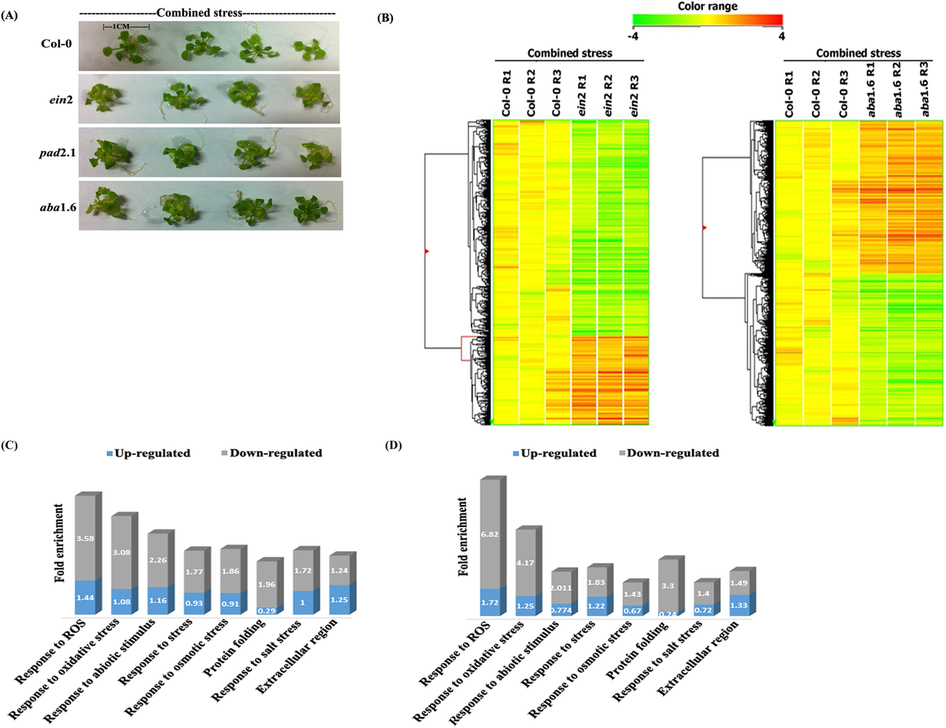Our official English website, www.x-mol.net, welcomes your
feedback! (Note: you will need to create a separate account there.)
Transcriptome analysis of Arabidopsis mutants suggests a crosstalk between ABA, ethylene and GSH against combined cold and osmotic stress.
Scientific Reports ( IF 3.8 ) Pub Date : 2016-11-15 , DOI: 10.1038/srep36867
Deepak Kumar , Saptarshi Hazra , Riddhi Datta , Sharmila Chattopadhyay
Scientific Reports ( IF 3.8 ) Pub Date : 2016-11-15 , DOI: 10.1038/srep36867
Deepak Kumar , Saptarshi Hazra , Riddhi Datta , Sharmila Chattopadhyay

|
The involvement of ethylene and abscisic acid in providing stress tolerance and defence response to plants is widely recognized. However, little is known about the cross-talk between glutathione with ethylene and abscisic acid to combat stress in planta. Here, transcriptome analysis of combined cold and osmotic stress treated Arabidopsis mutants were carried out to elucidate the crosstalk between the abscisic acid, ethylene and glutathione. Microarray experiment revealed the differential regulation of about 2313 and 4131 transcripts in ein2 (ethylene insensitive mutant) and aba1.6 (abscisic acid mutant) respectively. Functional analysis exposed common down-regulated stress and defence, secondary metabolite biosynthesis viz. phenylpropanoid, lignin and flavonols, redox and transcription factors related genes in ein2, aba1.6 and pad2.1 (glutathione mutant) in response to combined stress treatment. The reduced glutathione content was less in stress treated mutants in comparison to Col-0. Again, selective down-regulated transcripts in stress treated mutants were noted up-regulated after glutathione feeding. Some of the important differentially expressed genes were also validated by comparative proteomics analysis of stress treated mutants. In summary, our results suggested the role of ethylene and abscisic acid in inducing stress-responsive genes and proteins by activating glutathione biosynthesis to combat abiotic stress conditions in plant system.
中文翻译:

拟南芥突变体的转录组分析表明,ABA,乙烯和GSH之间的串扰抵御了寒冷和渗透胁迫的综合作用。
乙烯和脱落酸在提供对植物的胁迫耐受性和防御反应中的作用已得到广泛认可。然而,关于谷胱甘肽与乙烯和脱落酸之间对抗植物压力的了解甚少。在这里,进行了结合冷和渗透胁迫处理的拟南芥突变体的转录组分析,以阐明脱落酸,乙烯和谷胱甘肽之间的串扰。微阵列实验揭示了在ein2(对乙烯不敏感的突变体)和aba1.6(脱落酸突变体)中分别约2313和4131转录物的差异调控。功能分析揭示了常见的下调的压力和防御力,即次生代谢产物的生物合成。ein2,aba1.6和pad2中的苯丙烷,木质素和黄酮醇,氧化还原和转录因子相关基因。1(谷胱甘肽突变体)响应联合应激处理。与Col-0相比,应激处理的突变体中减少的谷胱甘肽含量更少。同样,在谷胱甘肽饲喂后,应激处理的突变体中选择性下调的转录本被上调。一些重要的差异表达基因也通过应激处理突变体的比较蛋白质组学分析得到了验证。总之,我们的研究结果表明乙烯和脱落酸通过激活谷胱甘肽的生物合成来对抗植物系统中的非生物胁迫条件,在诱导胁迫响应基因和蛋白质中发挥作用。谷胱甘肽喂养后,应激处理的突变体中选择性下调的转录本被上调。一些重要的差异表达基因也通过应激处理突变体的比较蛋白质组学分析得到了验证。总之,我们的研究结果表明乙烯和脱落酸通过激活谷胱甘肽的生物合成来对抗植物系统中的非生物胁迫条件,在诱导胁迫响应基因和蛋白质中发挥作用。谷胱甘肽喂养后,应激处理的突变体中选择性下调的转录本被上调。一些重要的差异表达基因也通过应激处理突变体的比较蛋白质组学分析得到了验证。总之,我们的研究结果表明乙烯和脱落酸通过激活谷胱甘肽的生物合成来对抗植物系统中的非生物胁迫条件,在诱导胁迫响应基因和蛋白质中发挥作用。
更新日期:2016-11-17
中文翻译:

拟南芥突变体的转录组分析表明,ABA,乙烯和GSH之间的串扰抵御了寒冷和渗透胁迫的综合作用。
乙烯和脱落酸在提供对植物的胁迫耐受性和防御反应中的作用已得到广泛认可。然而,关于谷胱甘肽与乙烯和脱落酸之间对抗植物压力的了解甚少。在这里,进行了结合冷和渗透胁迫处理的拟南芥突变体的转录组分析,以阐明脱落酸,乙烯和谷胱甘肽之间的串扰。微阵列实验揭示了在ein2(对乙烯不敏感的突变体)和aba1.6(脱落酸突变体)中分别约2313和4131转录物的差异调控。功能分析揭示了常见的下调的压力和防御力,即次生代谢产物的生物合成。ein2,aba1.6和pad2中的苯丙烷,木质素和黄酮醇,氧化还原和转录因子相关基因。1(谷胱甘肽突变体)响应联合应激处理。与Col-0相比,应激处理的突变体中减少的谷胱甘肽含量更少。同样,在谷胱甘肽饲喂后,应激处理的突变体中选择性下调的转录本被上调。一些重要的差异表达基因也通过应激处理突变体的比较蛋白质组学分析得到了验证。总之,我们的研究结果表明乙烯和脱落酸通过激活谷胱甘肽的生物合成来对抗植物系统中的非生物胁迫条件,在诱导胁迫响应基因和蛋白质中发挥作用。谷胱甘肽喂养后,应激处理的突变体中选择性下调的转录本被上调。一些重要的差异表达基因也通过应激处理突变体的比较蛋白质组学分析得到了验证。总之,我们的研究结果表明乙烯和脱落酸通过激活谷胱甘肽的生物合成来对抗植物系统中的非生物胁迫条件,在诱导胁迫响应基因和蛋白质中发挥作用。谷胱甘肽喂养后,应激处理的突变体中选择性下调的转录本被上调。一些重要的差异表达基因也通过应激处理突变体的比较蛋白质组学分析得到了验证。总之,我们的研究结果表明乙烯和脱落酸通过激活谷胱甘肽的生物合成来对抗植物系统中的非生物胁迫条件,在诱导胁迫响应基因和蛋白质中发挥作用。

































 京公网安备 11010802027423号
京公网安备 11010802027423号